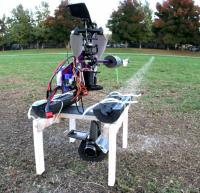Archive for November, 2006 - Page 2
-
 Views: 409
Views: 409
That's right, battery freaks, Max Amp arrived. 4000mAh, 11.1V. -
 Views: 306
Views: 306
Enough power to destroy Road Island. -
 Views: 372
Views: 372
You're probably going "Why did that Mor*on wire Dean the wrong way?" Well it's an attempt to make him more water resistant. -
 Views: 324
Views: 324
Only when a nose is pointing in is there life being lived. Still only lighting with the magorator but as inconvenient as it looks, it's still the best way to keep oriented. -
 Views: 377
Views: 377
Some closeups. Lighting with the magorator is definitely the poor programmers method, but U get used to it. -
 Views: 345
Views: 345
The rotor does not spin clockwise. The flash cooled off while the shutter was still open.
Comments (3)
Add Comment
-
 Views: 485
Views: 485
Camera mount 2, the foam monster -
 Views: 359
Views: 359
Effect of wind on camera roll. -
 Views: 438
Views: 438
Camera mount 2, the foam monster -
 Views: 385
Views: 385
Camera mount 2 takes off. -
 Views: 370
Views: 370
Final image before tail rotor failure. -
 Views: 370
Views: 370
Still rolling right despite all the weight on the left, probably due to the high wind. -
 Views: 326
Views: 326
Much less vibration with the 360' foam skids. -
 Views: 456
Views: 456
Much less vibration with the 360' foam skids.
-
 Views: 569
Views: 569
The first camera mount was the lightest, cheapest, simplest mount possible, made from scrap balsa from Heroine 1860. High definition camera is padded, just in case. -
 Views: 492
Views: 492
The first camera mount was the lightest, cheapest, simplest mount possible, made from scrap balsa from Heroine 1860. High definition camera is padded, just in case. -
 Views: 410
Views: 410
The battery was so lopsided, even the weight of the camera couldn't level it. -
 Views: 511
Views: 511
The most level shot on the hard drive. Shortly after takeoff all these kids wandered on the field picking up trash, oblivious to the flying machete. -
 Views: 427
Views: 427
Self portraits are the hardest since they require flying nose-in. -
 Views: 491
Views: 491
This business of dumping trash on the ground and then sending designated trash picker uppers to clean it up during helicopter flights seems to be an American theme. -
 Views: 417
Views: 417
Our first view from space without the use of an airliner. -
 Views: 393
Views: 393
Your SheCam traffic report.














